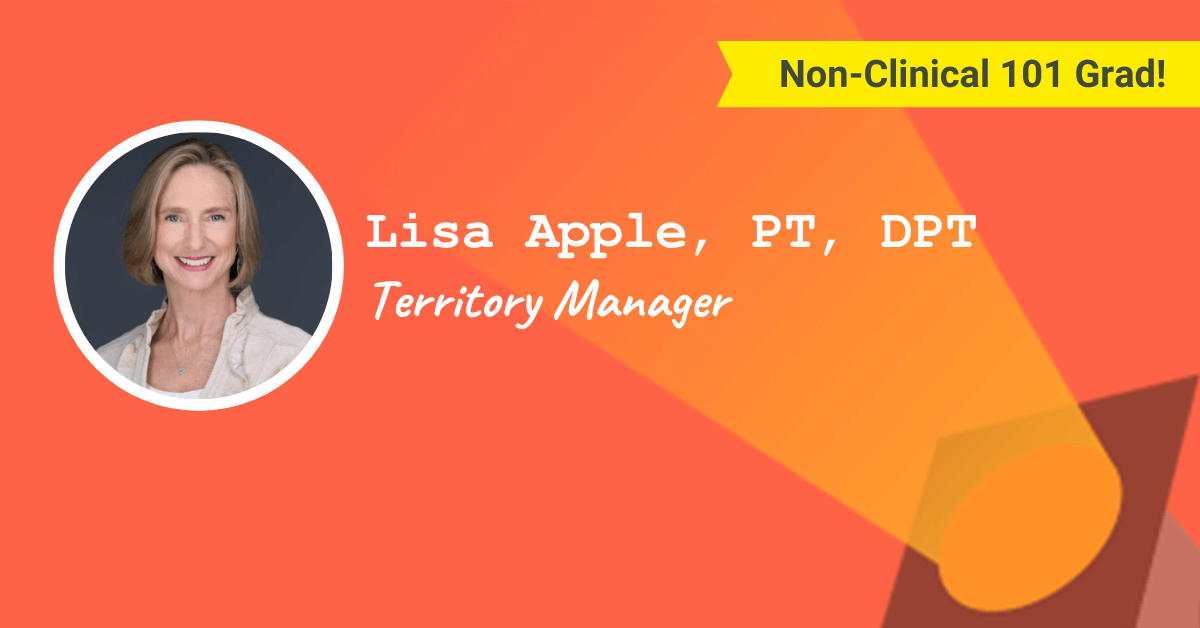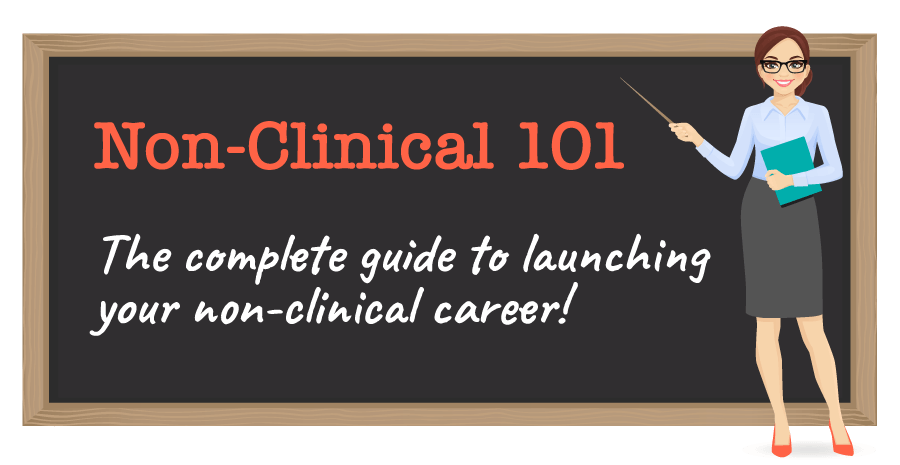This week’s spotlight is on Lisa Apple, PT, DPT, a Non-Clinical 101 graduate who is now Territory Manager for Penumbra!
This post may contain affiliate links or codes. This won’t increase your cost, but it helps keep TNCPT alive, and free of annoying ads! Thank you for your support. 🙂
What is your full name, title, and company name for your current, primary role?
Lisa Apple, PT, DPT — Territory Manager for Penumbra, Inc. Immersive Healthcare Division

Where are you located?
Seattle, WA.
Where did you go to PT school, and what year did you graduate?
University of Washington, 2009.
Please refrain from contacting our spotlight participants on social media. There are thousands of readers just like you out there. 🙂 Please ask your questions in the comments on this blog post.
If you’re a Non-Clinical 101 student, you can network with many of our spotlight participants in the alumni groups!
What did you do when you first finished school, and for how long?
I worked for an outpatient PT clinic for a year then transitioned to work as a pediatric therapist for Seattle Children’s Hospital for about six years. Then, I started my own outpatient clinic specializing in scoliosis and dance rehab.
In what setting(s) did you work, and what types of patients did you treat?
I worked mostly in outpatient but did some work in home health. I treated chronic pain, scoliosis, dancers and skaters, as well as patients with neurological diagnoses.
What did you enjoy about your early roles? What didn’t you enjoy?
I enjoyed helping to open new satellite clinics when I worked at Seattle Children’s Hospital, creating content for the website about common injuries, and presenting on scoliosis and common dance injuries.
I did not enjoy the shifts that I had to agree to, often shifting from a 7am – 5pm schedule to an 11am – 7pm schedule. I also found it difficult to wait for approval to make things happen in a larger hospital system. I wanted to move faster when it came to helping patients.
What else have you done since then, prior to your current role?
I opened my own business and ran that for over eight years in two different states. I combined both PT and Pilates, as well as Schroth Physical Therapy, for patients from British Columbia to CA. People would seek out my certifications in Schroth and Orthopedic Movement Therapy.
I also helped to create a website with a friend called Mindfulness for Dancers, contributing content for both conditioning and mindfulness.
When and why did you decide to do something non-clinical?
It was after I worked on the content for the website and owned my business that I realized I enjoyed working outside of a normal 9-5 type shift, and I enjoyed creating something beyond what I could do one on one with a patient.
What are you doing these days?
In 2022, I decided not to renew my lease for my business and took Therapy Blogging 101 with The Non-Clinical PT. I used this in my first step out of the clinic. I continued to see patients working in home health.
Then, I explored more non-clinical options in Non-Clinical 101 and realized I could use my favorite parts from my career as a physical therapist to pursue a territory manager position in the rehab space. I enjoyed research, presentation, communication and negotiation. I worked for Bioventus for a year in the rehab division and honed many of those skills in a medical sales position.
I now work for Penumbra, Inc. in the Immersive Division, helping to integrate a clinically designed, engaging and informative technology into rehabilitation and wellness facilities.
Are you still treating patients, or are you solely non-clinical?
When I bring virtual reality into facilities, I still work with patients alongside their therapists, showing them how to utilize this technology to get better outcomes, motivation and inform a therapeutic plan of care facilitating recovery from a wide variety of diagnoses.
What percentage of your time is spent clinically vs. non-clinically?
My role is primarily non-clinical. However, I do assist clinicians in clinical decision making, lending my clinical expertise. I advise PTs, OTs and SLPs on how to apply the experiences and activities of virtual reality for specific diagnoses or to achieve functional goals.
How long have you been in your current territory manager role?
I have worked in a medical sales territory manager role since February 2023. I have been in my current role for almost six months.
What do you wish you would’ve known before going into this role?
I wish I had known that all the skills I was using in the clinic are transferable. Running a business helped me tremendously to manage a book of business, balance a budget and strive towards a number. Learning how to articulate my experience and what I was doing naturally was the missing piece.
Did you get any special certifications or training along the way to help you get into your current role?
I learned so much from Non-Clinical 101 and Therapy Blogging 101. All of the wonderful content helped me narrow down what was most appealing about a non-clinical role.
I then went on to read everything from You Are a Badass, Untamed, Big Magic, to Playing Big.
I enrolled and got my certification in Evolve Your Success and found some amazing mentors after I decided that staying involved in business and sales was what I wanted.
How did you find your job? Did you apply or find it through a connection?
In my first non-clinical role as a territory manager, I found the listing on LinkedIn from a recruiter. For my current role, I was recruited by the company.
Did you do anything special to your resume and cover letter to land the job?
I completely changed my resume for each role I applied for, utilizing key words from the job description and linking them to transferable skills such as purchasing capital equipment, balancing a budget, and excelling at customer success.
What was the interview like for the territory manager role?
The interview process for my non-clinical role was intense. I never want to undervalue the work we did as PTs in our clinicals prior to getting a PT job. Let’s face it: I worked for free…actually while paying tuition my last year of PT school to get my first PT job. However, when interviewing for a non-clinical role, they don’t normally get to see you working on the job before they pay you.
I did seven interviews for my role at Bioventus and four at Penumbra. In this non-clinical role, it is important to work with the different team members in your region, so it makes sense to me that interviews with multiple people at multiple levels of the business are required to make sure you can be an effective, autonomous worker in the field.
How have people reacted to you leaving patient care?
People have been supportive. Most PTs want to know if I still treat patients. Most of my patients were disappointed that I was not going to do full-time patient care anymore.
One patient in particular said something I will never forget, and she gave me the ultimate push. She said, “You are completely entitled to change what you want to do in this life.”
What’s a typical day or week in the life like for you? What types of tasks and responsibilities fill your time?
My typical day is either doing a presentation to a group of clinicians and working with their patients or making calls to set up all the details of travel, presentation, and communication with various hospitals or facilities. I could also be in a meeting to find the pain points and issues that the facility is trying to address with our specialized technology.
I do a lot of organization of accounts, contacts, and business plans, so a foundation is established and a pipeline of future business is in place for the quarters and year to come. I communicate with clinicians, problem solve patient cases, troubleshoot, and help patients thrive. It is always something different, which makes it a fast-paced, exciting way to work.
What are some of the rewards of your role? What are the biggest challenges?
I am rewarded by helping patients to achieve more in the therapeutic session as well as teaching clinicians a seamless and efficient way to do that. I enjoy the psychology of motivation and sales and figuring out why people need or want to make a change.
My biggest challenge is breaking through an initial stereotype that some clinicians have about salespeople…when clinicians are salespeople. We all sell a plan of care to patients and families. Now, I get to provide assistance to multiple patients and clinicians on a one-to-many scale vs. a one-to-one scale.
How did your clinical background prepare you for this role? Which skills transferred?
My background in the clinic prepared me to engage and communicate with a diverse group of people.
Establishing rapport and showing up as your authentic self is key to enjoying your work and motivating others. The ability to notice subtle changes in someone’s demeanor or in the environment has helped me in my current role. I believe years of working with patients helped me to hone this skill.
In the clinic, it is imperative to keep track of a lot of data with many different patients, plans of care, and keep calm despite juggling many plates.
Managing people, marketing, schedules, and a full patient load as a business owner enabled me to switch gears efficiently and prioritize what leads to success.
Roughly speaking, how are the hours and pay compared to patient care?
During the years that I worked a regular shift at a clinic or hospital, I still had to do notes away from the job. In my current role, the hours are regulated by me.
There is always something to do, or something that needs to be done. I have to prioritize and self-regulate so that I take time to disconnect.
What type of person do you think would do well in your territory manager role?
In order to do well in the type of role I have currently, it would be beneficial to be organized, plan ahead, enjoy meeting new people and not take hearing “no” personally.
Do you work remotely or onsite?
I work both remotely and onsite. When I schedule a patient day or an in-service, I travel to a clinical site. I work where I am, whether that is at home, in the airport or at a hotel when I need to plan or communicate with customers or patients.
Does your organization hire PT, OT, or SLP professionals into non-clinical roles? If so, what type of roles?
The organizations I have worked with hire PT, OT and SLP professionals into non-clinical roles as both clinical specialists and territory managers, as well as directors.
Did you read any books, take any courses, or do anything special overall to get you where you are today?
Yes, I took Non-Clinical 101, Evolve Your Success, and read the books listed earlier, as well as:
I had a mentor that told me to become a student of the sales cycle. To me, that means a student of psychology and motivation.
I have always been interested in psychology, and my undergraduate degree was in Health Psychology. I am inspired to keep learning about the integration of mind and body. My current role is the best blend of those skills.
What is a typical career path for someone in your territory manager role?
A typical career path could include any of the following:
- Becoming a senior territory manager
- Becoming a district or regional manager
- Adding geography to your territory
- Moving into marketing or education for new territory managers or clinical specialists
Editor’s note: Career growth is definitely possible in medical sales. Check out this spotlight on Adam Quire, PT, DPT, who is now Clinical Training Manager for Lifeward!
What is next for you? What are your high-level career aspirations?
My next step is to truly develop a robust pipeline in my business and educate clinicians through national conferences and regional hospitals symposiums about how important it is to integrate the body and mind through technology. I would like to help others make transitions into roles outside of the clinic or help train people in new roles in sales organizations.
What would you recommend to someone who is considering going into a role like yours? Do you have any special words of wisdom for the readers?
Spend some time considering how to adjust your perspective from compartmentalizing your work into 45-60 minute chunks to allowing yourself time to strategize and plan into the future.
This for me has been the biggest adjustment. As a therapist, you are on all the time with patients, and it is go go go. In my role now, I have to allow myself to examine many different accounts and take time to strategize how I want to approach certain key stakeholders.
What would you teach to today’s graduate students in your profession, if you had the opportunity?
I would teach PT students more about how to run a business, sales and communication.
Do you have any special advice for others who want to follow in your footsteps?
Reach out to people who are doing roles that you might want to explore. Spend some time figuring out what brings you joy and fulfillment.





